VOL. 29, #1, Spring 2011
Tucson Gem Shows 2011, Middle East Turmoil: Gems As Capital Flight, Collectors, Auction News, Gem Heists, In The News, Retail Gemstone Price Trends (1975-2010), Notable Quotes
- Home
- Newsletter
- VOL. 29, #1, Spring 2011
Tucson Gem Shows 2011, Middle East Turmoil: Gems As Capital Flight, Collectors, Auction News, Gem Heists, In The News, Retail Gemstone Price Trends (1975-2010), Notable Quotes
Middle East Turmoil: Gems As Capital Flight
by Robert Genis
The following article describes why the political upheaval in the Middle East is pushing up gem prices. Why are the wealthy buying gems?
We have always contended gemstones are the most concentrated form of wealth known to man. An ounce of top gem unheated Burma ruby could be worth over $60 million at today's prices. Compare that to gold. It would take over 42,000 ounces at $1400 per ounce or 2625 pounds to equal that amount. How about silver? At $35 per ounce, it would take over $1.7 million ounces to be worth $60 million.
That's over 100,000 pounds. You would need a forklift and tractor trailer to move your silver. Add in the fact both gold and silver set off metal detectors, it is obvious this is not a good way to move assets from country to country. How about cash? You would need 60 attaché cases. Kind of difficult to take that many suitcases through customs and put them in the overhead bin.
Of course, we assume many in the Middle East have offshore bank accounts in safe European havens. However, you never know when you might have to flee a bad political situation. Did the wealthy in Egypt expect a revolution? Did any of these countries see the revolutionary fervor spread like wildfire throughout this region? I doubt it. By the time things turn bad, it is probably too late to buy gems. So if you are a person who likes to prepare before a crisis, consider gems an insurance policy. These goods could save your life and wealth. Gems will always be the ultimate capital flight asset.
Mideast unrest pushing up gem prices, say traders
By Damon Wake
March 11, 2011
China Post
The political upheaval convulsing the Middle East is pushing up the price of high-quality gems, traders say, as the region's well-heeled look to convert their wealth into easily portable property.
The Middle East and North Africa have been rocked by unrest since an uprising in Tunisia in January brought down the government there and led to similar protests in Egypt which ousted president Hosni Mubarak last month.
Martin Rapaport, chairman of the Rapaport Group which runs one of the world's largest diamond trading networks, said prices for high-quality stones were being driven up as wealthy people in the region look to acquire "flight capital" -- high value items they can carry easily if they need to flee their country.
Gold and silver reached historic highs last week, with investors seeking refuge in safe havens as fears about the unrest spreading to the oil-rich Gulf states sent crude prices soaring above $100 a barrel.
Unlike bullion and cash, diamonds offer an easy way to transport huge sums without attracting too much attention, Rapaport said.
"If you want to move five million dollars out of the country and you wear a diamond ring and your wife or girlfriend wears a diamond ring, nobody tries to stop you at customs," he told AFP.
"It's like an insurance policy, plus it appreciates."
Rapaport said that while growing demand from China and India was fuelling price rises for low to medium grade gems, Middle East concerns were pushing up prices for higher quality diamonds.
The asking price for internally flawless D-colour three-carat diamonds on the RapNet diamond trading network rose to $73,000 per carat in late February, compared with $54,199 per carat a year earlier -- a jump of nearly 35 percent.
Rapaport Group research found average prices for all polished diamonds in February had risen 4.7 percent since the start of the year.
Continuing uncertainty in the Middle East could push prices even higher, Rapaport said, and he warned that if control of Saudi Arabia's oil supplies came into question the price of large diamonds could rise by as much as 50 percent in a short space of time.
Chang Hatta, the chairman of Hatta New World, a high-end jewellery firm based in Hong Kong and Taipei, said that for those who could afford them, the very best gems were a safe bet in tumultuous times.
"All the royal families in the Middle East buy precious stones. They have a problem in the Middle East. You can't carry the building, you can't carry the money. This you can carry," he told AFP at the Hong Kong International Jewellery Show this week.
At Hatta's glittering stall in the show's "Hall of Extraordinary", it was clear his products are aimed at those for whom money is no object -- and ostentation is not a dirty word.
Window after window glistened with cartoonishly large emeralds, ruby rings like knuckledusters, sapphires and gold, gold, gold.
The piece de resistance sat in a display by the stall's entrance -- a diamond-studded necklace of staggering opulence carrying a stunning, vivid turquoise pendant of Brazilian paraiba, one of the world's rarest gems.
Nikhil Jain of Bangkok-based Allure Jewels, which has been selling jewellery to royal families for three generations, agreed the unrest in the Arab world was affecting prices.
"In the Middle East, people are moving out of these countries. They don't want to live with the political hassle," he said.
Those rich enough to stock up on gemstones may not need to -- as Hatta observed.
"You can put a billion dollars' worth of stones (in your pocket), can carry, can walk away. So all the royal families do this. You know what I mean?" he said.
Collectors
Sun Drop Diamond At London Museum
A 110 carat yellow diamond is now on display in London's Natural History Museum. The diamond is on loan from diamond manufacturer Cora International. Yellow diamonds are the result of exposure to nitrogen in the carbon, which helps form a diamond. Cora International chief executive Suzette Gomes told BBC, "If the color is weaker you would cut a square to keep the color and make it stronger. If your color's very strong, you would cut a pear shape." The price of the diamond has yet to be announced.
78 carat diamond
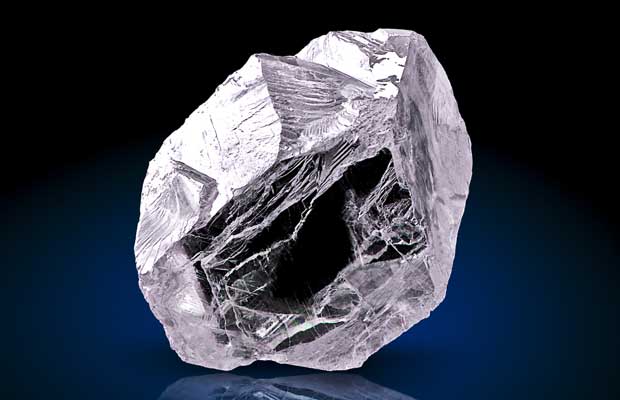
The 78 carat Ekati Spirit diamond from the Northwest Territories of Yellowknife in Canada was recently sold in Belgium for more than $2.8 million. The stone is reportedly colorless and flawless. This amount set a Canadian record for the most expensive diamond ever found in Canada. The previous record was $1.2 million for a pear-shaped, 10.22 carat gem from Ekati. The 78 carat stone measures 21 x 18 x 13 millimeters and is the size of a thumb. The buyer was not disclosed but it is believed one large diamond will be cut from the rough. A 182 carat diamond was also found and sold at the same sale but the diamond was lower quality.
Alligator Diamond/Ruby Guitar
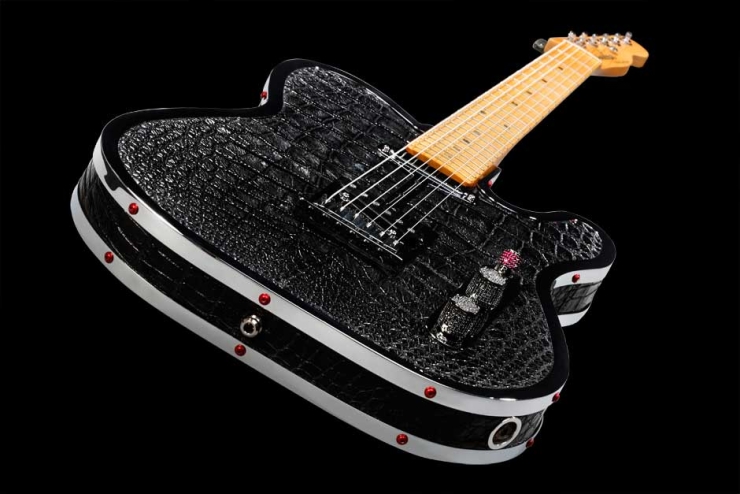
Rock Royalty has created a customized one-of-a-kind alligator guitar with a Fender Telecaster body. It features two handmade custom guitar volume knobs with 11.88 carats natural fancy black diamonds, a handmade guitar selector switch containing 2.30 carats red rubies and six handmade custom tuning keys with 15.54 carats natural fancy black diamonds. The gems are mounted in sterling silver finished with black ruthenium. This guitar is wrapped in natural black alligator from Louisiana with a patent-pending steel cage with chrome finish and red aluminum screws. For the rock star who has everything. The price? A cool $85,000.
Diamond Bezel For Apple iPhone 4

The new blinged out iPhone from ZShock takes opulence to a whole new level with its new diamond bezel. This will make your iphone different than everyone else. The diamond bezel has a precision fit that does not add bulk to the already small iPhone and allows for all the ports and buttons on the phone fully accessible. The iPhone Diamond Bezel is available in 14K, 18K solid gold or platinum and has over 22 carats of diamonds. The Diamond iPhone Bezel can also be ordered in various configurations, i.e. metals, and colored diamonds.
Auction News
Christie's New York April
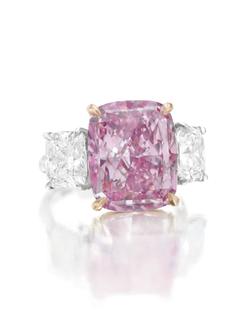 |
Christie's will offer a 10.09 Fancy Vivid purplish-pink diamond on April 12 Magnificent Jewels sale in New York. It is estimated to sell between $12-15 million.
Here is a recent list of important pink diamonds sold by Christie's:
The Perfect Pink
A 14.23 Fancy Intense pink rectangular-cut diamond
Hong Kong - November 29, 2010
US$23,165,968
US$ 1.6 million per carat
World Record Price for any Jewel Sold at Auction in Asia
The Vivid Pink
A 5.00 Fancy Vivid pink internally-flawless diamond Hong Kong - 1 December 2009
US$10,776,660
US$ 2.1 million per carat
World Auction Record Price Per Carat For Any Diamond
The 6.89 Fancy Vivid purple-pink diamond
New York - December 7, 2010
US$ 6,914,500
US$ 1 million per carat
The Rose of Dubai Diamond
A 25.02 Fancy Pink internally-flawless diamond
New York - October 19, 2005
US$ 6,008,000
Sotheby's Hong Kong April
Sotheby's magnificent Jewels will be held on April 16 in Hong Kong.
Here are some interesting pieces:
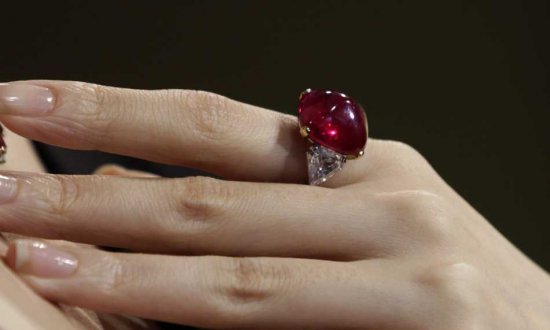
A 27.67 unheated Mogok Burma ruby. It is estimated to sell for $2.5 million or about $90,000 per carat. The reason it is not selling for more is the stone is a sugarloaf cabochon.
The infamous 1.92 red diamond. This stone was first sold in 2001 to an anonymous buyer for $1.6 million. It is graded fancy red and VS2. It is being offered at $2.5-$3 million. It did not sell at Sotheby's London for the same price. It is now mounted in a brooch instead of a ring. Some contend the grading is not accurate. Maybe it will finally find a home in the Far East?
A 1.13 Fancy Vivid Yellow Green diamond. The estimates are $500,000-$580,000.
A 23.19 Brazilian cats-eye alexandrite. Estimated between $1.3 and 1.6 million.
A 29.20 Burmese sapphire for $400,000-$600,000.
Two matched untreated Colombian emeralds weighing over 20 carats between $800,000-$1 million.
Gem Heist News
Gems From 2008 Paris Theft Found in Drainpipe
By Doreen Carvajal
New York Times
March 9, 2011
More than two years after men dressed in wigs and scarves struck the Harry Winston jewelry store in Paris's golden triangle of upscale shops, the police this week discovered a cache of sparkling diamonds from the theft in a far less glamorous place: a drainpipe in the northern suburbs of the city.
They found one diamond ring the size of a child's marble, along with 18 other rings and 3 earrings, in a plastic container inside a concrete mold at the home of the man suspected as the mastermind in Seine-Saint-Denis.
The police were saying little about Monday's discovery of jewelry valued at $20.6 million other than dryly describing the inventory. "We are saying nothing, nothing," a police spokeswoman said Tuesday. "The judge is not happy that the information came out."
The jewelry was part of a record haul during Christmastime 2008, when four men three dressed as women robbed the high-end jewelry store in the Eighth Arrondissement at closing time, grabbing their glittering goods within 15 minutes. The theft, which Harry Winston then valued at roughly $110 million, was called the robbery of the century by the French news media because the armed robbers had planned so precisely that they knew the names and addresses of some of the employees.
The men flaunted a hand grenade and, according to witnesses, barked orders in Eastern European accents, leading to widespread speculation that the robbery was a caper of the Pink Panther jewelry theft ring, which has roots in Serbia and is being hunted by Interpol.
In 2009, though, after an initial search of the house, the police detained 25 people, ranging in age from 22 to 67, with homegrown roots in the northern suburbs of Paris. Nine of them were later charged, including the man suspected as the mastermind, Daoudi Yahiaoui, 46, who owns the house where the jewels were discovered and who is already in jail, awaiting sentencing in the robbery.
During the first search of the house, the police recovered expensive watches and rings hidden behind a false wall that were later displayed at a news conference. More than $1.4 million in cash was also found in different hiding places, along with a shotgun and a rocket launcher. But investigators were convinced that more jewels were hidden away.
The thieves made one crucial error: leaving behind a purse with traceable DNA. Investigators also dissected the accents heard on security tapes and realized that the robbers did not have Slavic accents, but the French of the Parisian suburbs. Those clues led them to a chain of local fences, petty criminals and foreign jewelry appraisers, and finally to the jewels themselves.
Since the robbery, Harry Winston reduced the value of the stolen jewelry to the wholesale price of $32 million, receiving a $20 million insurance settlement, according to its annual reports.
But the risk adjusters and insurance syndicates with Lloyd's of London, Harry Winston's insurer, posted a $1 million reward immediately after the robbery for information leading to the recovery of the diamonds. The insurance investigators for Lloyd's, who had always harbored suspicions that the thieves were homegrown, placed a classified notice in the local daily, Le Parisien, which circulates in the outskirts of Paris.
Snatch-type Heist
By Denise Romano
Rapaport
March 4, 2011
A judge convicted two New York diamond dealers Mahaveer Kankariya and Atul Shah of staging a phony "Snatch"-style diamond heist at their own place of business with the intent of claiming a $7 million insurance prize. Lawyers for the dealers argued that the New Year's Eve 2008 diamond heist at Dialite Imports was a real robbery.
Prosecutors uncovered surveillance video of Shah and Kankariya removing goods from the office safe and placing empty boxes inside before the fake gunmen arrived. The dealers were alleged to have poured drain cleaner on surveillance cameras to destroy the footage, but its main motherboard was still in tact and provided the incriminating evidence.
The judge viewed footage from the Dialite shop, which showed Shah buzzing-in two gunmen who were dressed in, what appears fake beards, and traditional Hasidic overcoats and hats. The footage shows the two men, who have not been identified, tying up Shah and removing boxes from the open safe. Defendants claimed the two gunmen were couriers. The judge determined that the entire robbery "frankly, looks like a joke." Sentencing will be determined later, as of press time.
As the New York Daily News reported, the robbery seemed reminiscent of a scene from Guy Ritchie's 2001 movie "Snatch," where lead actor Benicio del Toro and a group of scammers posed as Hasidic men with fake guns, beards and garb to rob a jewelry store, walking away with millions in jewels.
Police tighten snare on Pink Panther pair
by Maey El Shoush
The National
February 17, 2011
Police are close to tracking down the last two suspects in the 2007 Wafi City jewellery heist, investigators said at the close of an international conference held to track down the Pink Panther gang.
Four years ago, seven men used stolen vehicles to drive into Wafi Mall and smash their way into House of Graff, escaping with diamonds worth Dh14.7 million.
The men were part of an international crime syndicate, known as the Pink Panther gang, thought to be responsible for the theft of more than Dh1.5 billion worth of gems in 90 robberies. "The group is constantly changing its tactics to evade capture, but with new details we are closing in on them," said Lt Col Salem Al Rumaithi, deputy director of the criminal investigation department at Dubai Police.
This week Dubai Police investigators met with 76 fellow detectives from 26 countries at the fifth annual Pink Panther symposium, held at The Officers Club in Garhoud. The secretary general of Interpol, Richard Noble, was there, as were French and Swiss police and representatives of Europol, the European Union's detective force.
Local investigators say that studying the gang's latest tactics was the highlight of the meeting. Dubai Police say the exchanged of information - and continued international collaboration to combat and prevent organised crime - provided the missing pieces of the puzzle and arrests are imminent.
Detectives said crucial evidence had come to light during the conference, which would help trace the robbers, but did not provide further details for operational reasons.
In recent months, at least one member of the Pink Panther gang is arrested somewhere in the world every four weeks, according to Lt Col Al Rumaithi. Many of the suspects are from Serbia.
"This meeting with our colleagues is about how we can help each other prevent such crimes," he said. "We study how Pink Panther carries out these robberies, where stolen goods are hidden and new ways vehicles are stolen."
The first big heist with which the gangsters are credited was in London in 1993, when they stole a diamond worth £500,000 (Dh2.9m) by hiding it in a jar of face cream - a trick they appear to have lifted from a Pink Panther film.
In The News
Treasure hunting holidays
by Kim Wildman
MSN
March 11, 2011
Whether you dream of unearthing rare precious gems or discovering the fossilised remains of an extinct dinosaur on your next holiday, there's a wealth of treasure hunting possibilities on offer. From panning for gold in California to excavating Roman ruins in England, here's our top pick of the world's best treasure hunting holiday hot spots.
Pan for gold
With gold prices on the rise, there's never been a better time to plan a gold-rush holiday. One of the best places to strike it rich is at the Roaring Camp in California. Situated on the banks of the Mokelumne River, the mine was a camp for gold prospectors, known as the 49ers, during the 1848-55 California Gold Rush. Visitors can tour the operating gold mine and then try their luck at sluicing, dry-washing, dredging or panning for gold.
The camp also offers other activities including rafting, camping, swimming, fishing and hiking on trails used by the original 49ers. Each Saturday, the camp hosts a free cookout for campers, which includes a museum tour and gold-panning lesson.
Beachcomb for amber
Along the Baltic coastline of Europe there are more than seashells and pumice stones to be discovered. The wave-lashed coastline, shared by nine countries (including Denmark, Estonia, Latvia, Finland, Germany, Lithuania, Poland, Russia and Sweden) is home to the largest known deposit of amber.
In fact, the fossilised tree resin that's found here accounts for about 80 percent of the world's amber. The best areas to go beachcombing for the yellow, orange and brown-tinged gems are along the Russian and Polish sections of the coast. To maximise your chances, try looking at low tide after a storm.
Mine for diamonds
Love diamonds but can't afford the hefty price tag? Then give the fancy jewellery store a miss and head to the Crater of Diamonds State Park to see what you can dig up. Located in Arkansas, in the US, the 15-hectare mining field is the only diamond producing site in the world where the general public can search for diamonds. What's more, it's finder keepers. So whatever treasures you dig up, you get to take home. Around 600 diamonds are discovered here each year, with the largest diamond dug up in 1924 coming in at just over 40 carats and the most recent big find of 4.68 carats being plucked from the earth in 2008. You can bring your own tools or rent them from the park and camping facilities are available.
Noodle for opals
For anyone with opal fever, Coober Pedy in South Australia is the place to noodle or fossick for the colourful gemstones. With more than 85 percent of the world's opal mined from 70 different fields around this quiet underground outback town, you're bound to find something that'll make your eyes sparkle. Afterwards you can explore the underground museum, see the world's first underground church or check in to a room in the town's famous underground motel. Above ground there's the barren Moon Plains and the 5300km Dog Fence, the longest fence in the world, to discover.
Buried treasures
Fancy yourself as a swashbuckling Indiana Jones or a feisty Lara Croft? Then grab your compass and backpack. From excavating an early Roman settlement in England to preserving ancient Inca sites in Peru, Responsible Travel lists 16 archaeology holidays that will allow you to live out your wildest fantasy while helping preserve some of the world's greatest ancient treasures. While budding palaeontologists can step back in time with a prehistoric holiday on a professional dinosaur dig in Montana.
Sunken treasures
If it's sunken treasure that you seek, then you can join Captain Greg Bounds and his Gold Hound Treasure Divers as they scour the ocean off the Florida coastline for treasures from the past. For a fee, advanced certified divers can dive with the crew on a day's search as they recover gold and other treasure from sunken Spanish galleons. This is an excellent opportunity for treasure-hunting enthusiasts to see and experience an advanced treasure hunt using the latest techniques and equipment. Unfortunately, you must turn in any treasures you find so it can be restored and catalogued. But on the bright side, as Captain Bounds notes, you'll help rewrite history.
J&K floats global tender for mining Kashmir sapphire
Financial Press
Press Trust of India
March 14, 2011
Famous for their unique peacock blue colour, Kashmir sapphires will soon make a comeback in the international markets with the state government floating a global tender for extraction of the gemstones from Paddar Valley, in Kishtwar district.
"The government has gone for global tendering to ensure systematic extraction of sapphire at Paddar Valley. The step has been initiated to ensure competitive bidding at a large scale with utmost transparency," said Surjeet Singh Salthia, state minister for industries and commerce.
"We have already received one tender from a global company, which is is yet to be opened. We are expecting some more in this regard," Salathia added.
Government-run J&K Minerals had invited expression of interest (EOI) from parties with expertise in exploration, mine planning and mining of gemstones for undertaking exploration and exploitation of sapphires through a joint venture (JV), the minister said.
According to a notice of J&K Minerals, the precious mineral is world famous because of its unique peacock blue colour, which is rarely available in other parts of the world. The sapphires are renowned for their clarity and transparency and are mainly used for jewellery.
Till now, extreme geographical conditions and lack of resources have hampered the commercial exploitation of this valuable natural reserve. "We expect to see change on this front soon, as the government has entered into the final stage of awarding the tender of extraction," they said.
Firms will be assessed for their financial and technical capability, as well as past experience, to ensure that the sapphires are mined in the best manner.
Gems Emporium Opens in Naypyidaw
By Wai Moe
Irrawaddy
March 21, 2011
The Burmese military regime launched the 48th Gems Emporium in its administration capital Naypyidaw on Thursday, selling and exporting precious stones to international customers, mostly from China, despite Western sanctions. The gems emporium follows the success of last year's fair when the junta netted an estimated US $1.7 billion in jade sales. On Tuesday, ahead of the opening ceremony, junta chief Snr-Gen Than Shwe arrived at the venue along with five top generals: Maung Aye, Shwe Mann, Thein Sein, Tin Aung Myint Oo and Tin Aye, some of whom appeared in military uniform while others wore civilian dress. Their pictures appeared in a state-run-newspaper, The New Light of Myanmar, which highlighted the significant of the Gems Emporium. Also attending were Gen Min Aung Hlaing, the current Joint-Chief of Staff (Army, Navy, Air Force) who was promoted to a four-star general last week, and another of Than Shwe's favorite generals, Brig-Gen Maung Maung Aye, the commander of the Naypyidaw regional military command. Two top military cronies, Aung Ko Win who is a patron of the Myanmar Gems Entrepreneurs Association, and Tay Za who chairs the association, were also at the venue during the generals' visit. According to state media, the emporium is scheduled to be held on March 10-22 ahead of the 66th anniversary of Armed Forces Day on March 27. The organizers said they expected 4,000 gems merchants from 10 countries to visit the emporium while over 5,000 merchants from 20 countries were invited. "Altogether 16,939 jade lots, 206 gems lots and 255 pearl lots will be on sale at the 48th Myanma Gems Emporium," The New Light of Myanmar reported. Thanks to China's giant economy, the Burmese regime has enjoyed increased earnings from exporting gems, even though Western countries' sanctions target Burmese gems. Burma earned $1.7 billion from selling jade to neighboring countries in 2010, an increase from $198 million in 2005, officials said.
According to data and photographic evidence gleaned from gems emporiums in Naypyidaw over the past two years, the regime sells gems in Euros, not US dollars. One jade lot sold to a Chinese businessman at the emporium in late 2010 was valued at more than Euro 5 million.
Military-run Myanmar Economic Holdings Ltd and companies run by cronies, such as Tay Za's Htoo Group of Companies, Zaw Zaw's Max Myanmar Group of Companies, and Ne Win Tun's Ruby Dragon Jade & Gems Co Ltd, are involved in jade and other gem mining in Burma.
In recent years, Max Myanmar unearthed an enormous slab of jade weighing 115,000 kg from one of its sites in Hpakant Township, Kachin State.
Although Burma earned $1.7 billion from jade exports last year, few if any benefits are passed on to ordinary citizens, including local Kachin people who say they see nothing from the mining profits. Burma ranked second from bottom of Transparency International's 2010 corruption index out of 178 countries.
Retail Gemstone Price Trends (1975-2010)
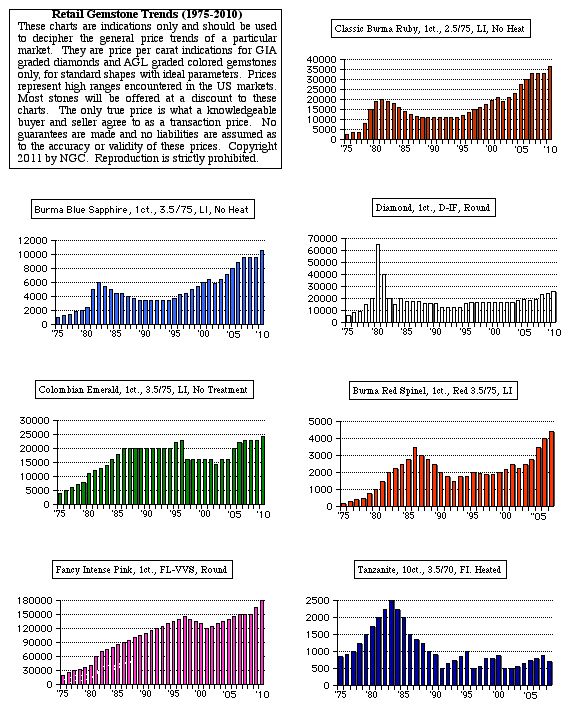 |
Notable Quotes
"The Chinese like impressive stones and they're looking for perfection. You can show them a 100-carat yellow diamond that has some imperfection in purity or a 20-carat supervivid yellow flawless diamond. They'll go for the flawless diamond. They want to buy the best, and they're very savvy. They have educated themselves sale by sale, and they're buying very well."
Rahul Kadakia, Head of Jewelry at Christie's New York.
New York Times
March 18, 2011
"Collector demand for large colored diamonds has never been stronger, especially where pink diamonds of this size and quality are concerned. Fewer than 10 percent of all pink diamonds mined weigh more than 0.20 carats, and even fewer exhibit the exceptional color saturation and brilliance of this exceptional gem. In all my years at Christie's, I have never seen such vivid color in a stone of this size,"
Rahul Kadakia, Head of Jewelry at Christie's New York.
Christie's catalog
Spring, 2011
"Diamonds are a "readily portable" store of wealth, which is often attractive to rich people who live in politically unstable parts of the world."
Robert Gannicott, chief executive, Harry Winston Toronto
Barrons
March 11, 2011
Stones from Burma continue to surface. "One would be naive to think that some new Burmese material isn't coming into the United States."
Stuart Robertson
JCK
February, 2011
"The emeralds most sought after by the Hollywood stars continue to be Colombian, because of their size."
Oscar Baquero, president of the Colombian Emerald Federation
Colombia Reports
March 10, 2011